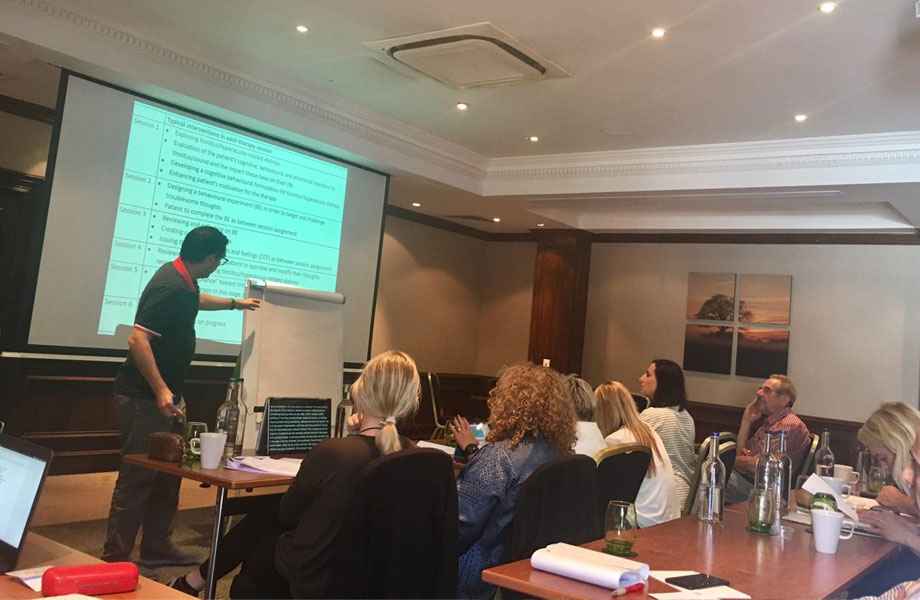Suicide and self-harm
There are several reports suggesting a high prevalence of psychological disturbances in patients suffering from tinnitus and hyperacusis (Pinto et al. 2014; Juris et al. 2013; Schecklmann et al. 2014; Andersson et al. 2004; Pattyn et al. 2016; Paulin et al. 2016; Aazh & Allott 2016; Aazh & Moore 2017b; Aazh & Moore 2017a). Patients suffering from psychological disturbances are more likely to develop suicidal or self-harm ideations. It is important to investigate suicidal ideations, as they are associated with suicidal behaviour, even though only a small proportion of those with suicidal ideations actually attempt suicide (Kessler et al. 1999; Suominen et al. 2004).
What is the prevalence of suicidal and self-harm ideations?
A recent analysis by Dr. Aazh’s tinnitus team including the data for over 650 patients who sought help for tinnitus and/or hyperacusis showed that suicidal and self-harm ideations are present in 15% of the patients.
Should I ask about suicidal thoughts?
It is important for the non-psychologists to know that there is no convincing evidence that asking patients about suicidal ideations increase the risk of patients committing suicide (Cowen et al. 2012). In the Oxford handbook of Psychiatry, Cowen et al (2012) highlighted that someone who has already thought of suicide is likely to feel relieved when the clinician raises the issue. Enquiring about suicidal inclinations can help the patient to talk about their intentions and feel that they are better understood by their clinician which in turn may reduce the risk of suicidal behaviour (Cowen, Harrison, & Burns, 2012). Audiology departments play a major role in offering therapy and support for patients experiencing tinnitus and hyperacusis (Thompson et al. 2017; Thompson et al. 2018; Aazh et al. 2018a; Aazh & Moore 2018b; Aazh & Moore 2018a). Audiologists who are involved in tinnitus and hyperacusis rehabilitation should be alert to factors that predict suicidal and self-harm ideations in this population.
What are the factors that predict suicidal and self-harm ideations in patients seeking help for tinnitus and/or hyperacusis?
Based on the results of the pioneering studies by Dr.Aazh’s tinnitus team, the two variables that are associated with the risk of suicidal and self-harm ideations are patients’ childhood history of parental mental illness and their current depression level (Aazh et al. 2018b; Aazh & Moore 2018c).
As shown in the table below, the relationship between childhood history of parental mental illness and the suicidal and self-harm ideations remained significant in the adjusted model. This suggests that even taking into account the impact of depression, which is known to be associated with suicidal risk, the childhood history of parental mental illness has a screening value in identifying patients who may be at risk for developing suicidal and self-harm ideations.
Table. Logistic regression model showing the odds ratio (OR) for suicidal and self-harm ideations (dependent variable). Unadjusted OR values and adjusted OR values and their 95% confidence intervals (CI) are presented (n = 279). The adjusted OR takes into account the effects of age and gender in addition to the effects of other variables in the model. Variables included in the model were presence or absence of parental mental illness and categories based on scores for the THI (Tinnitus Handicap Inventory), HQ (Hyperacusis Questionnaire), GAD-7 (Generalised Anxiety Disorder), and PHQ-9 (Patient Health Questionnaire).
| Variables | Unadjusted OR (95% CI) | p | Adjusted OR (95% CI) | p |
|---|---|---|---|---|
|
Parental mental illness No Yes |
1.0 3.3 (1.7 to 6.3) |
< .001 |
1.0 2.5 (1.14 to 5.6) |
.022 |
|
Tinnitus handicap category No handicap (THI score 0-16) Mild (THI score 18-36) Moderate (THI score 38-56) Severe (THI score 58-100) |
1.0 0.88 (0.087 to 8.9) 2.7 (0.31 to 22.5) 8.5 (1.1 to 65.9) |
.91 .36 .04 |
1.0 1.17 (0.09 to 14.7) 2.15 (0.2 to 22.4) 2.3 (23 to 22.1) |
.9 .52 .48 |
|
Hyperacusis handicap No (HQ < 22) Yes (HQ ≥ 22) |
1.0 2.57 (1.35 to 4.9) |
.004 |
1.0 0.8 (0.36 to 1.77) |
.57 |
|
Anxiety Normal (GAD-7 < 8) Abnormal (GAD-7 ≥ 8) |
1.0 8.96 (3.8 to 20.9) |
< .001 |
1.0 2.03 (0.62 to 6.6) |
.24 |
|
Depression Normal (PHQ-9 < 10) Abnormal (PHQ-9 ≥ 10) |
1.0 14.3 (5.8 to 35.8) |
< .001 |
1.0 7.7 (2.6 to 26.3) |
.001 |
Note: Significant p values are indicated in bold font.
What to do?
If patients express thoughts of harming themselves or others they should immediately be put in touch with their GP or with a psychiatrist in order to receive appropriate care and support.
References
Aazh, H., & Allott, R. (2016). Cognitive behavioural therapy in management of hyperacusis: a narrative review and clinical implementation. Auditory and Vestibular Research, 25, 63-74.
Aazh, H., Knipper, M., Danesh, A. A., et al. (2018a). Insights from the third international conference on hyperacusis: causes, evaluation, diagnosis, and treatment. Noise Health, 20, 162-170.
Aazh, H., Landgrebe, M., & Danesh, A. A. (2018b). Parental mental illness in childhood as a risk factor for suicidal and self-harm ideations in adults seeking help for tinnitus and/or hyperacusis. American Journal of Audiolgy, [in press]
Aazh, H., & Moore, B. C. J. (2017a). Factors Associated with Depression in Patients with Tinnitus and Hyperacusis. American Journal of Audiology, 26, 562-569.
Aazh, H., & Moore, B. C. J. (2017b). Usefulness of self-report questionnaires for psychological assessment of patients with tinnitus and hyperacusis and patients’ views of the questionnaires. International Journal of Audiology, 56, 489-498.
Aazh, H., & Moore, B. C. J. (2018a). Effectiveness of audiologist-delivered cognitive behavioral therapy for tinnitus and hyperacusis rehabilitation: outcomes for patients treated in routine practice American Journal of Audiolgy, [Epub ahead of print], 1-12.
Aazh, H., & Moore, B. C. J. (2018b). Proportion and characteristics of patients who were offered, enrolled in and completed audiologist-delivered cognitive behavioural therapy for tinnitus and hyperacusis rehabilitation in a specialist UK clinic. Int J Audiol, 1-11.
Aazh, H., & Moore, B. C. J. (2018c). Thoughts about suicide and self-harm in patients with tinnitus and hyperacusis. Journal of American Academy of Audiology, 29, 255-261.
Andersson, G., Carlbring, P., Kaldo, V., et al. (2004). Screening of psychiatric disorders via the Internet. A pilot study with tinnitus patients. Nord J Psychiatry, 58, 287-91.
Cowen, P., Harrison, P., & Burns, T. (2012). Shorter Oxford Textbook of Psychiatry. Oxford: Oxford University Press.
Juris, L., Andersson, G., Larsen, H. C., et al. (2013). Psychiatric comorbidity and personality traits in patients with hyperacusis. Int J Audiol, 52, 230-5.
Kessler, R. C., Borges, G., & Walters, E. E. (1999). Prevalence of and risk factors for lifetime suicide attempts in the National Comorbidity Survey. Arch Gen Psychiatry, 56, 617-626.
Pattyn, T., Van Den Eede, F., Vanneste, S., et al. (2016). Tinnitus and anxiety disorders: A review. Hear Res, 333, 255-265.
Paulin, J., Andersson, L., & Nordin, S. (2016). Characteristics of hyperacusis in the general population. Noise Health, 18, 178-84.
Pinto, P. C., Marcelos, C. M., Mezzasalma, M. A., et al. (2014). Tinnitus and its association with psychiatric disorders: systematic review. J Laryngol Otol, 128, 660-4.
Schecklmann, M., Landgrebe, M., Langguth, B., et al. (2014). Phenotypic characteristics of hyperacusis in tinnitus. PLoS One, 9, e86944.
Suominen, K., Isometsa, E., & Suokas, J. (2004). Completed suicide after a suicide attempt: a 37-year follow up study. . Am J Psychiatry, 161, 562-563.
Thompson, D. M., Hall, D. A., Walker, D. M., et al. (2017). Psychological therapy for people with tinnitus: a scoping review of treatment components. Ear Hear, 38, 149-158.
Thompson, D. M., Taylor, J., Hall, D. A., et al. (2018). Patients’ and Clinicians’ Views of the Psychological Components of Tinnitus Treatment That Could Inform Audiologists’ Usual Care: A Delphi Survey. Ear Hear, 39, 367-377.
Read MoreCookie settings
REJECTACCEPT
Privacy Overview
| Cookie | Duration | Description |
|---|---|---|
| __stripe_mid | 1 year | Stripe sets this cookie cookie to process payments. |
| __stripe_sid | 30 minutes | Stripe sets this cookie cookie to process payments. |
| cookielawinfo-checkbox-advertisement | 1 year | Set by the GDPR Cookie Consent plugin, this cookie is used to record the user consent for the cookies in the "Advertisement" category . |
| cookielawinfo-checkbox-analytics | 11 months | This cookie is set by GDPR Cookie Consent plugin. The cookie is used to store the user consent for the cookies in the category "Analytics". |
| cookielawinfo-checkbox-functional | 11 months | The cookie is set by GDPR cookie consent to record the user consent for the cookies in the category "Functional". |
| cookielawinfo-checkbox-necessary | 11 months | This cookie is set by GDPR Cookie Consent plugin. The cookies is used to store the user consent for the cookies in the category "Necessary". |
| cookielawinfo-checkbox-others | 11 months | This cookie is set by GDPR Cookie Consent plugin. The cookie is used to store the user consent for the cookies in the category "Other. |
| cookielawinfo-checkbox-performance | 11 months | This cookie is set by GDPR Cookie Consent plugin. The cookie is used to store the user consent for the cookies in the category "Performance". |
| viewed_cookie_policy | 11 months | The cookie is set by the GDPR Cookie Consent plugin and is used to store whether or not user has consented to the use of cookies. It does not store any personal data. |
| Cookie | Duration | Description |
|---|---|---|
| _ga | 2 years | The _ga cookie, installed by Google Analytics, calculates visitor, session and campaign data and also keeps track of site usage for the site's analytics report. The cookie stores information anonymously and assigns a randomly generated number to recognize unique visitors. |
| _gat_gtag_UA_131443801_1 | 1 minute | Set by Google to distinguish users. |
| _gid | 1 day | Installed by Google Analytics, _gid cookie stores information on how visitors use a website, while also creating an analytics report of the website's performance. Some of the data that are collected include the number of visitors, their source, and the pages they visit anonymously. |
| CONSENT | 2 years | YouTube sets this cookie via embedded youtube-videos and registers anonymous statistical data. |
| Cookie | Duration | Description |
|---|---|---|
| VISITOR_INFO1_LIVE | 5 months 27 days | A cookie set by YouTube to measure bandwidth that determines whether the user gets the new or old player interface. |
| YSC | session | YSC cookie is set by Youtube and is used to track the views of embedded videos on Youtube pages. |
| yt-remote-connected-devices | never | YouTube sets this cookie to store the video preferences of the user using embedded YouTube video. |
| yt-remote-device-id | never | YouTube sets this cookie to store the video preferences of the user using embedded YouTube video. |
| yt.innertube::nextId | never | This cookie, set by YouTube, registers a unique ID to store data on what videos from YouTube the user has seen. |
| yt.innertube::requests | never | This cookie, set by YouTube, registers a unique ID to store data on what videos from YouTube the user has seen. |
| Cookie | Duration | Description |
|---|---|---|
| m | 2 years | No description available. |



